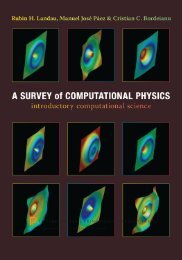Statistical Physics
Statistical Physics
Statistical Physics
- No tags were found...
Create successful ePaper yourself
Turn your PDF publications into a flip-book with our unique Google optimized e-Paper software.
7Magnetic MaterialsWe have applied the methods of statistical physics to several systems in theprevious chapters. The systems that we have considered so far are simple, sincethey are noninteracting systems. In this chapter we investigate the Ising modelas a model for ferromagnetic systems, in which interaction plays an importantrole. A ferromagnetic system undergoes a phase transition at high temperatureto a paramagnetic phase. We discuss this transition by use of a mean-fieldtheory. We also calculate the exact free energy for a one-dimensional system.7.1 Origin of Permanent MagnetismSome kinds of atoms have a magnetic moment. That is, those atoms behaveas small permanent magnets. When a crystal contains such atoms, it is a realizationof a system in which tiny magnetic moments are placed regularly ina crystal lattice. Under suitable conditions, these magnetic moments becomealigned in a common direction. The whole crystal then behaves as a permanentmagnet. When this alignment happens, the crystal is said to be ferromagnetic.At higher temperatures, the moments in a ferromagnetic material cease to bealigned, because of thermal fluctuations; it then becomes paramagnetic.In this section, we explain what a magnetic moment of an atom is, and whythese magnetic moments become aligned. First, we shall explain the magneticmoment. An atom consists of electrons and a nucleus. The nucleus consistsof protons and neutrons. These particles have a spin angular momentum S,which can be considered as a rotation of the particle. The magnitude of S isfixed at /2 for these particles. This rotation leads to a circulating electriccurrent, and a magnetic moment µ. It is evident that this moment should beproportional to the angular velocity and the charge of the particle. For thesame angular momentum, a heavier system rotates more slowly, and so we expectthe magnetic moment of a nucleon to be smaller than that of an electron.Thesizeofµ for the electron, proton, and neutron is given in Table 7.1. Thereason that the neutron has a nonzero µ is that it consists of charged quarks.











![Práctica [PDF] - Universidad de Carabobo, FACYT - computacion](https://img.yumpu.com/48491415/1/190x245/practica-pdf-universidad-de-carabobo-facyt-computacion.jpg?quality=85)




